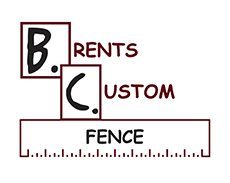Why Choosing the Right Wood Makes All the Difference
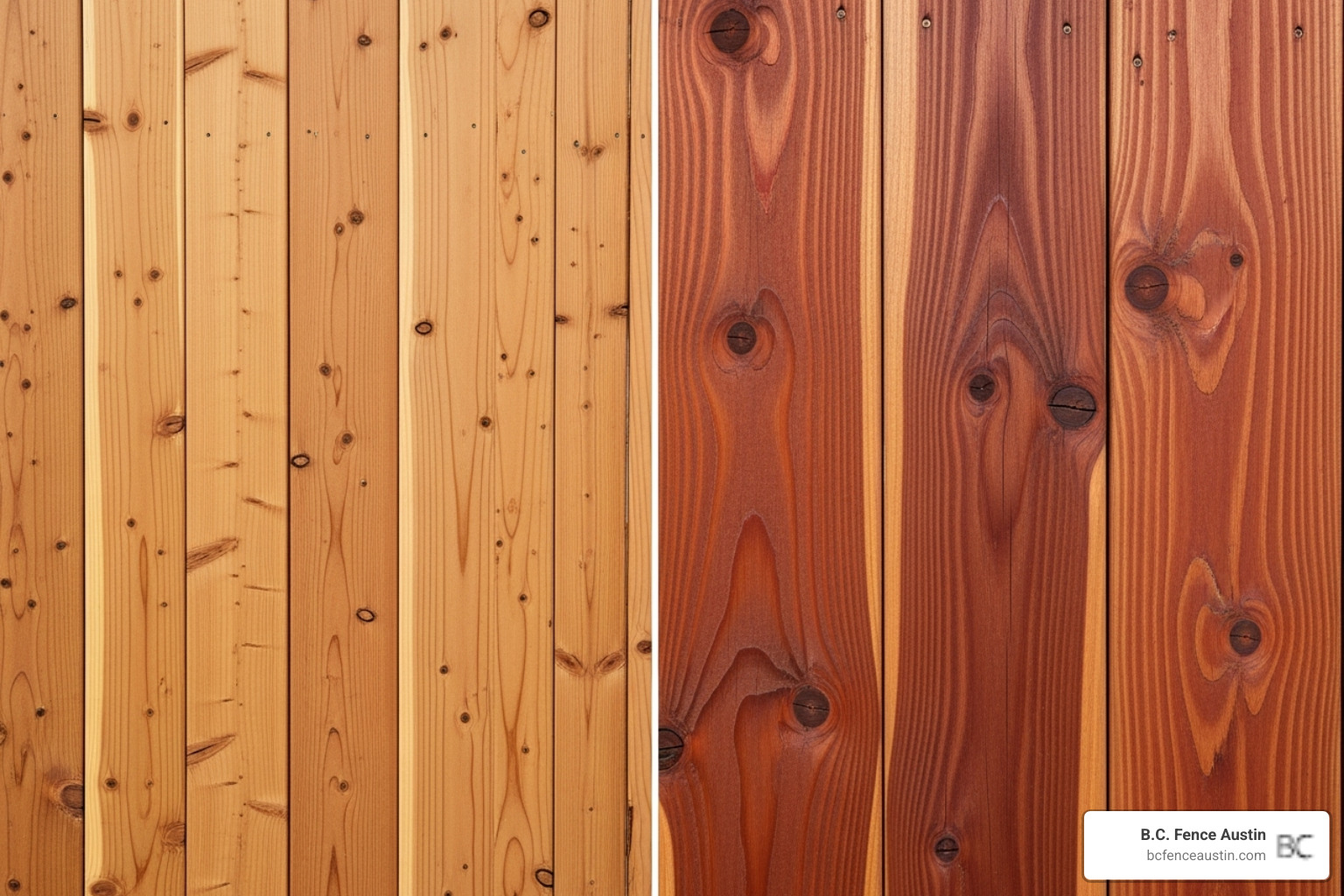
When deciding on a cedar vs redwood fence, you’re looking at two premium wood options that will protect your family and improve your home’s beauty for decades to come. Both offer natural resistance to rot and insects, but they differ significantly in strength, appearance, and long-term value.
Quick comparison for cedar vs redwood fence:
- Durability: Redwood is 23% stronger (450 lbs Janka rating vs cedar’s 350 lbs)
- Lifespan: Cedar lasts up to 40 years when treated; redwood typically 15-25 years
- Appearance: Redwood has deep reddish-brown hues; cedar offers varied tones from yellowish to reddish-brown
- Maintenance: Redwood needs resealing every 3-5 years; cedar requires more frequent upkeep
- Customization: Cedar accepts stains and paint easily; redwood’s natural oils can interfere with paint adhesion
As one fence expert puts it: “Redwood. Cedar. A battle for the ages in the decking and outdoor lumber industry.” The truth is, both woods have earned their reputation as top choices for homeowners who want natural beauty without sacrificing durability.
Your choice ultimately depends on your priorities. Cedar offers excellent value with proven longevity in Central Texas climates, while redwood provides superior strength and a distinctive look that deepens with age.
The key is understanding how each wood performs in real-world conditions – from Austin’s humid summers to the occasional freeze. Both will give you the privacy, security, and curb appeal you’re looking for, but the details matter when you’re investing in your property’s future.
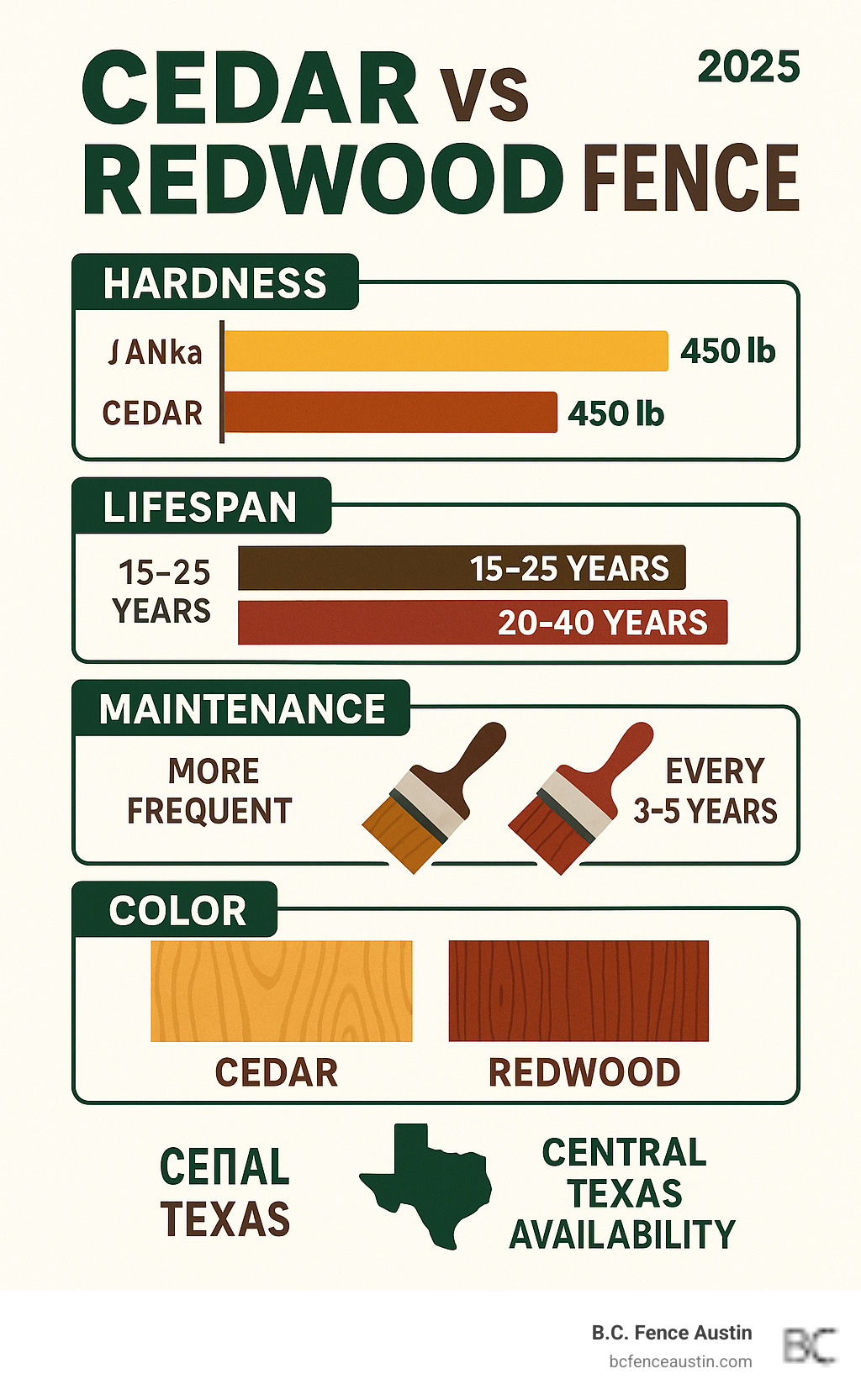
Appearance and Aesthetics: The First Impression
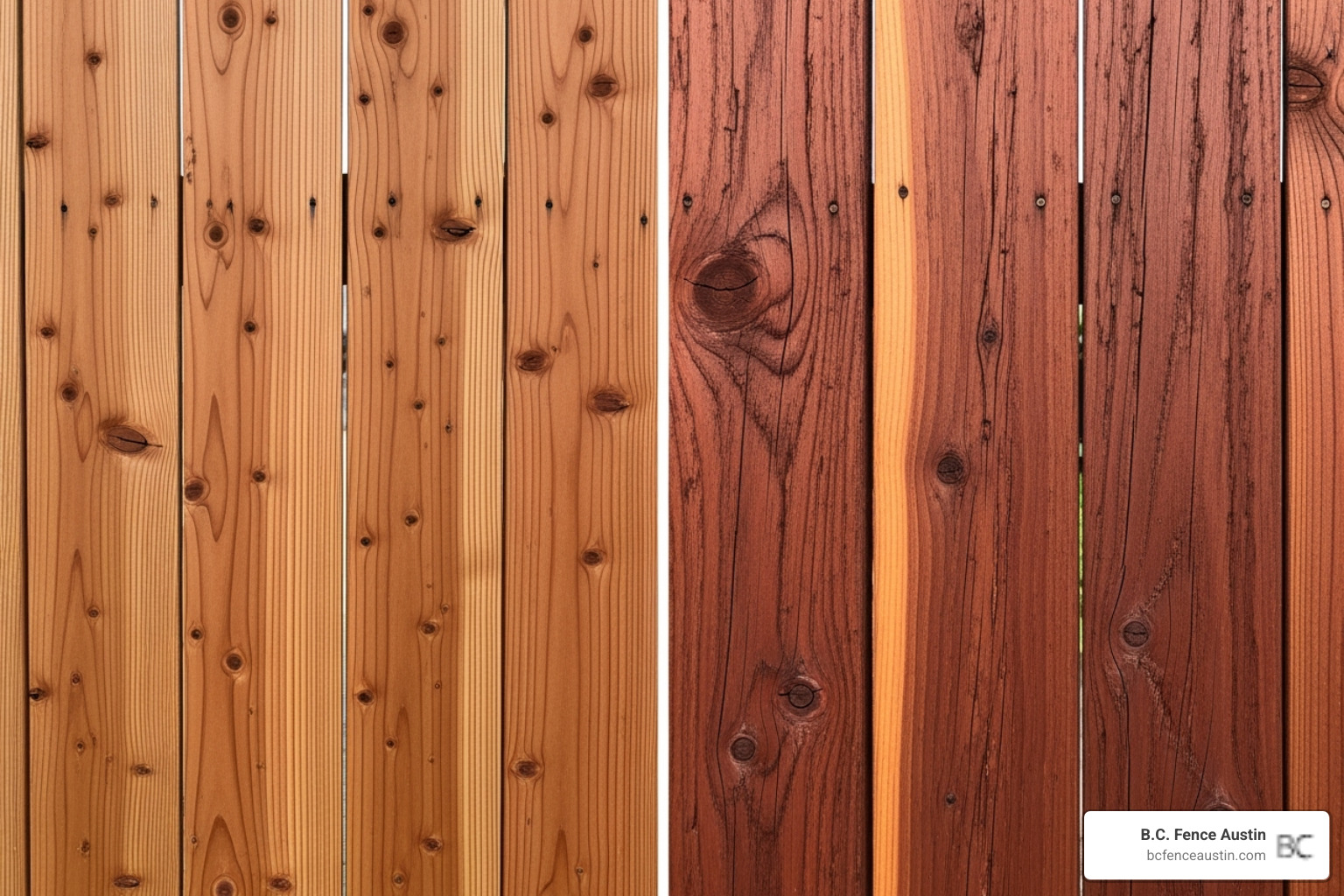
Your fence is the first thing neighbors and visitors notice about your property. When it comes to a cedar vs redwood fence, both woods bring their own personality to your landscape, but they couldn’t be more different in how they look and feel.
Color and Grain Variations
Redwood makes a bold statement with its signature deep reddish-brown color. This rich, warm tone stays consistent across the fence and actually gets more beautiful over time, deepening into an even richer hue. The grain patterns in redwood are typically smooth and straight, especially in clear grades where you won’t find knots interrupting the clean lines.
Cedar tells a different story with its varied personality. Western Red Cedar can surprise you with colors ranging from pale yellowish tones to warm reddish-browns, sometimes even showing grayish hints. This natural variety means your fence will have character right from day one.
What really sets cedar apart is its knotty character. While clear grades are available, many homeowners fall in love with cedar’s tight knots that create unique patterns across each panel. These knots give your fence a rustic, authentic feel that’s perfect if you want something that looks naturally weathered and charming.
How They Age: Weathering and Patina
Here’s where both woods show their true beauty. Left untreated, both cedar and redwood will gradually transform into a gorgeous silver-gray patina that blends seamlessly with any landscape. It’s like watching your fence develop its own natural artwork over the years.
Redwood’s natural oils help it maintain its original color longer than most woods. If you love that rich reddish tone, you can preserve it with staining every few years. The color actually deepens with age, creating an even more striking appearance than when it was first installed.
Cedar develops its patina differently, with the varied tones creating a beautiful weathered look that many homeowners specifically seek out. While the original colors may fade more noticeably if left untreated, cedar accepts stains beautifully if you want to preserve or change its appearance.
The choice between maintaining the neat, refined look of preserved redwood or embracing the rustic character of weathered cedar often comes down to your home’s style and your personal taste. For detailed guidance on keeping your cedar looking its best, check out our comprehensive guide on cedar fence care.
The Core of Durability: Cedar vs Redwood Fence Strength and Longevity
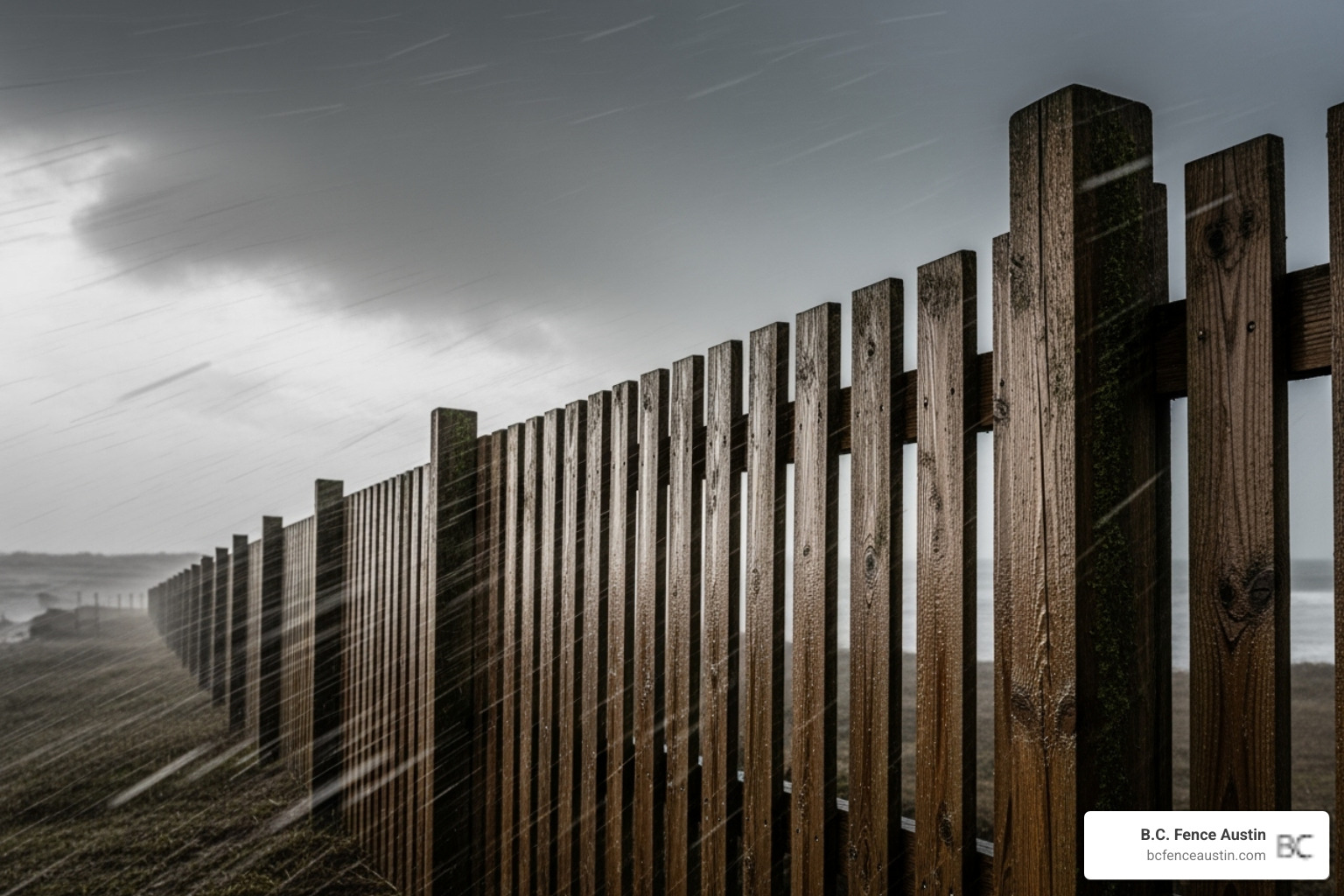
When investing in a fence, you need it to stand strong. Both cedar and redwood are tough, reliable choices, but their durability differs. Understanding these differences is crucial when deciding on a cedar vs redwood fence for your Austin home.
The best way to measure wood strength is through the Janka hardness test, which tells us how well a wood resists denting and wear. You can Learn about the Janka scale to see how this scientific measurement translates to real-world performance.
Resistance to Rot, Insects, and Warping
Cedar and redwood contain natural oils and tannins that act as built-in protection against rot, decay, and insects. These aren’t added chemicals; they’re part of what makes these trees special.
Redwood’s impressive natural oils keep it moisturized, preventing cracking and simplifying maintenance. All-heartwood redwood (the dense center) offers maximum protection against termites and carpenter ants. Its typical three-quarter-inch thickness provides excellent stability.
Cedar has its own strengths. Its tannins inhibit rot, and it often outlasts mixed-grade redwood because cedar lacks vulnerable sapwood. Cedar boards are typically five-eighths of an inch thick and provide excellent protection.
Both woods handle moisture resistance beautifully. Redwood’s density gives it superior warp resistance. Cedar can be more prone to warping, but adding a middle rail during installation easily solves this. For more detailed answers about cedar’s performance, check out our Top FAQs about cedar wood fences.
Strength and Hardness Comparison
When it comes to raw strength, the Janka rating scale gives us a clear picture of how these woods stack up against impact and wear.
Redwood scores 450 pounds on the Janka scale, while cedar comes in at 350 pounds. That makes redwood about 23% stronger than cedar when it comes to resisting dents and dings. If you’re worried about potential impacts, redwood’s higher density gives it a clear advantage.
However, both are still considered softwoods, and both perform exceptionally well for fencing. Cedar’s slightly lower hardness doesn’t mean it’s weak; it just means redwood can take a bit more punishment.
One tip that applies to both: consider using steel posts instead of wood posts. Since fence posts take the most abuse from ground moisture, steel posts can significantly extend your fence’s overall lifespan regardless of which wood you choose for the panels.
Lifespan Expectations for a Cedar vs Redwood Fence
The lifespan of your cedar vs redwood fence depends heavily on the grade of wood, your local climate, installation quality, and how well you maintain it.
Cedar fences can be champions of longevity. With proper treatment, Western Red Cedar fences can last up to 40 years. Even without maintenance, they typically last 15 to 30 years in our Austin climate.
Redwood fences generally last 15 to 25 years, with premium all-heartwood redwood potentially reaching 30 years with excellent care. The key word here is “grade.”
Many don’t realize that a well-maintained cedar fence often outlasts a typical redwood fence. While premium, all-heartwood redwood is incredibly durable, the more common mixed-grade redwood may not always beat a properly cared-for cedar fence.
In Austin’s humid climate, both woods need attention. Redwood needs sealing every three to five years, while cedar benefits from more frequent maintenance. That extra attention to cedar often results in a fence that serves your family for decades.
The bottom line? Both woods can give you excellent longevity, but the winner often comes down to the specific grade you choose and how well you care for it. For specific tips on getting the most from your redwood investment, you can Read about redwood fence care.
Maintenance, Customization, and Installation

Once your new fence is installed, you’ll want to keep it looking its best. Both cedar and redwood are naturally low-maintenance compared to other wood options, but understanding their specific needs will help you make the smartest choice for your lifestyle.
Maintenance Needs for a Cedar vs Redwood Fence
Redwood shines in the maintenance department. Its natural oils mean it typically only needs resealing every three to five years to maintain its gorgeous color and protective qualities. A gentle cleaning with mild soap and water once a year keeps it looking fresh.
Cedar requires a bit more attention. It benefits from annual cleaning and more frequent staining or sealing to prevent moisture absorption and maintain its rich appearance. This time investment pays off in longevity.
For both woods, annual cleaning is key. A simple wash with soap and water removes dirt and debris that can harbor moisture. If you notice mildew, a mild bleach-and-water solution takes care of it. Remember to skip the pressure washer—it can damage the wood fibers and shorten your fence’s life.
Power washing might seem like a time-saver, but it’s often too harsh for wood fencing. Stick with a garden hose and some elbow grease for the best results. If you’re curious about how different fence materials compare in terms of upkeep, check out our comprehensive guide to Compare fence materials.
Customization: Staining and Painting
Want to match your fence to your home’s exterior? Your choice between cedar vs redwood fence materials will impact your customization options.
Cedar is like a blank canvas. Its lighter color and porous grain make it incredibly receptive to both stains and paints. Whether you want a transparent stain or a solid color, cedar delivers excellent results. The stain absorption is exceptional, allowing you to achieve rich, even colors.
Redwood is different. While stunning in its natural state, its beneficial oils can be tricky for painting. Redwood’s natural oils can bleed through paint, creating discoloration without specialized primers. However, it takes transparent and semi-transparent stains beautifully, enhancing its rich reddish-brown tones.
Paint adhesion on cedar is superior to redwood, making it the better choice if you’re dreaming of a crisp white picket fence. Redwood is happiest when you’re enhancing its natural grain rather than covering it.
Installation and Workability
Regarding the installation process, both woods have advantages and feel quite different to work with.
Cedar is lighter and more forgiving during installation, making it more DIY-friendly. It cuts cleanly and is less likely to crack or split when you drive in fasteners.
Redwood is denser and requires sharper tools for clean cuts. This density means nailing without pre-drilling can sometimes split the wood. However, once fasteners are in, redwood holds them exceptionally well, contributing to long-term structural integrity.
Both woods are excellent choices for professional installation, which we recommend for most homeowners. A properly installed fence ensures years of trouble-free enjoyment, regardless of which wood you choose.
Installation considerations include using stainless steel fasteners with redwood to prevent tannin staining, ensuring proper post depth, considering extra support rails for cedar, and following local building codes.
The weight difference can impact installation time, with cedar’s lighter weight making it faster to handle. However, both materials are well within the range of what experienced fence installers work with regularly.
Practical Factors: Availability, Cost, and Environmental Impact
Beyond aesthetics and durability, practical considerations like regional availability, overall cost, and environmental impact play a significant role in choosing between a cedar vs redwood fence. These factors can influence everything from project timelines to your long-term peace of mind about making an eco-conscious choice. For a quick overview of how these two woods stack up, check out A comparison of cedar and redwood.
Regional Availability and Sourcing
Where your fence material comes from makes a bigger difference than you might think, especially here in Central Texas.
Redwood grows exclusively along the West Coast, primarily in California and parts of Oregon. While this makes redwood readily available for homeowners in those areas, it becomes significantly more challenging to source as you move inland. For us here in Austin, redwood has to travel over 1,000 miles to reach your backyard. This long journey not only affects pricing but can also impact project timelines if supply runs low.
Finding replacement boards down the road can be another headache with redwood. If a storm damages a section of your fence or you want to add a gate later, sourcing matching redwood boards locally can be tricky and time-consuming.
Cedar, particularly Western Red Cedar, has a much broader growing range across the Northeastern United States and Canada. This widespread distribution means cedar is consistently available nationwide, including right here in Central Texas. We work with cedar regularly, and the reliable supply chain means smoother project scheduling and easier access to materials for future repairs or additions.
The availability advantage of cedar in our region is one reason why it’s become such a popular choice for Austin homeowners. You’re not fighting against geography when you choose cedar.
Environmental and Sustainability Factors
More homeowners are thinking about the environmental impact of their building materials, and both woods have compelling sustainability stories when sourced responsibly.
Both cedar and redwood are available with Forest Stewardship Council (FSC) certification. This certification means the wood comes from forests managed according to strict environmental and social standards. When you choose FSC-certified lumber, you’re supporting responsible forestry practices that protect wildlife habitats and ensure forests remain healthy for future generations. You can learn more about what this certification means at FSC certification.
Sustainable harvesting practices vary between suppliers, but some are leading by example. Certain redwood suppliers actively manage their forests to harvest less than the annual growth rate, meaning their redwood supply actually increases over time. While cedar production is substantial – nearly 1 billion board feet annually for Western Red Cedar – the specific commitment to growth exceeding harvest rates isn’t as universally documented.
The growth cycles of these trees tell an interesting story about sustainability. Cedar seedlings typically reach harvest size in about 60 years, while redwood trees often require over 100 years to mature. This longer growth cycle contributes to redwood’s relative scarcity and reinforces why responsible harvesting is so critical.
Carbon footprint is another factor where cedar often comes out ahead. Cedar lumber can be up to four times lighter than redwood, which translates directly to reduced fuel consumption during transportation. When your fence material travels hundreds of miles less and weighs significantly less, the environmental savings add up quickly.
Both woods are biodegradable and renewable resources, making them environmentally friendly choices compared to synthetic fencing materials that may never break down naturally. Whether you choose cedar or redwood, you’re investing in a material that works with nature rather than against it.
Cedar vs. Redwood: At-a-Glance Comparison
When you’re weighing your options for a cedar vs redwood fence, it helps to see the key differences laid out clearly. Both woods offer excellent value, but they shine in different areas depending on your specific needs and priorities.
| Feature | Cedar | Redwood |
|---|---|---|
| Appearance | Varied tones (yellowish to reddish-brown), often knotty, rustic feel | Rich reddish-brown, fine grain, can be clear (knot-free), neat look |
| Durability (Janka) | 350 lbs (softer) | 450 lbs (23% stronger) |
| Lifespan | 15-30 years (untreated), up to 40 years (treated) | 15-25 years (typical), 20-30+ years (high-grade) |
| Maintenance | More frequent sealing (annual) | Less frequent sealing (every 3-5 years) |
| Customization | Excellent for staining/painting, absorbs well | Stains subtly, challenging to paint (oils bleed) |
| Availability | Widely available nationwide | More common on West Coast, scarcer elsewhere |
| Environmental Impact | Lighter weight (smaller carbon footprint), ~60-year harvest cycle | Often harvested below growth rate, ~100+ year harvest cycle |
Frequently Asked Questions about Cedar and Redwood Fences
When we’re helping homeowners choose between wood fencing options, the same thoughtful questions come up again and again. Here are the answers to the most common concerns we hear about cedar vs redwood fence choices:
Which wood is better for a fence in a humid climate like Austin’s?
Here’s the good news – both woods are naturally built to handle humidity! Their natural resistance to rot and insects makes them excellent choices for Central Texas weather.
Redwood does have a slight technical advantage with its higher density and oil content, which can offer extra protection against moisture. But here’s what we’ve learned from years of installing fences in Austin: a properly maintained cedar fence performs beautifully in our humid climate and is the widely-used choice throughout Central Texas.
The real secret isn’t which wood you choose – it’s consistent maintenance. In Austin’s climate, ensuring good drainage around your fence posts and keeping up with regular sealing will make a bigger difference than the initial wood selection. Both cedar and redwood have proven track records for lasting decades in our local conditions when cared for properly.
Does redwood really last longer than cedar?
This question deserves a nuanced answer because it’s not as straightforward as many people think!
While redwood is indeed harder and all-heartwood, premium-grade redwood can outlast almost any other wood, the real lifespan depends heavily on three key factors: the specific grade of wood, maintenance practices, and local climate conditions.
Here’s what often surprises homeowners: common, mixed-grade redwood (which includes sapwood that’s more susceptible to decay) may not necessarily last longer than a well-maintained cedar fence. In fact, cedar typically outlives mixed heartwood/sapwood redwood because cedar has no vulnerable sapwood to worry about.
In many real-world scenarios, especially with proper treatment and consistent upkeep, a cedar fence can have a comparable or even longer lifespan than a typical redwood fence. It’s less about which wood always lasts longer and more about how it’s sourced, installed, and cared for.
Is it harder to install a redwood fence than a cedar fence?
Both woods are relatively easy to work with for experienced installers, but they do have different personalities when it comes to installation.
Cedar is lighter, which makes it more manageable during handling and transportation. This can be especially helpful for DIY projects or when working on larger installations. Cedar’s softer nature also means it’s easier to cut and nail without splitting, making it more forgiving during construction.
Redwood’s density and strength mean it requires sharp tools for clean cuts and benefits from pre-drilling to avoid splitting when nailing. However, this same density gives redwood exceptional stability once it’s installed – it holds fasteners incredibly well and resists warping.
For professional installers like our team, the differences in installation difficulty are minor. Both woods allow us to create efficient and high-quality fence construction. The choice often comes down to your specific project needs rather than installation complexity.
Conclusion: Making the Right Choice for Your Property
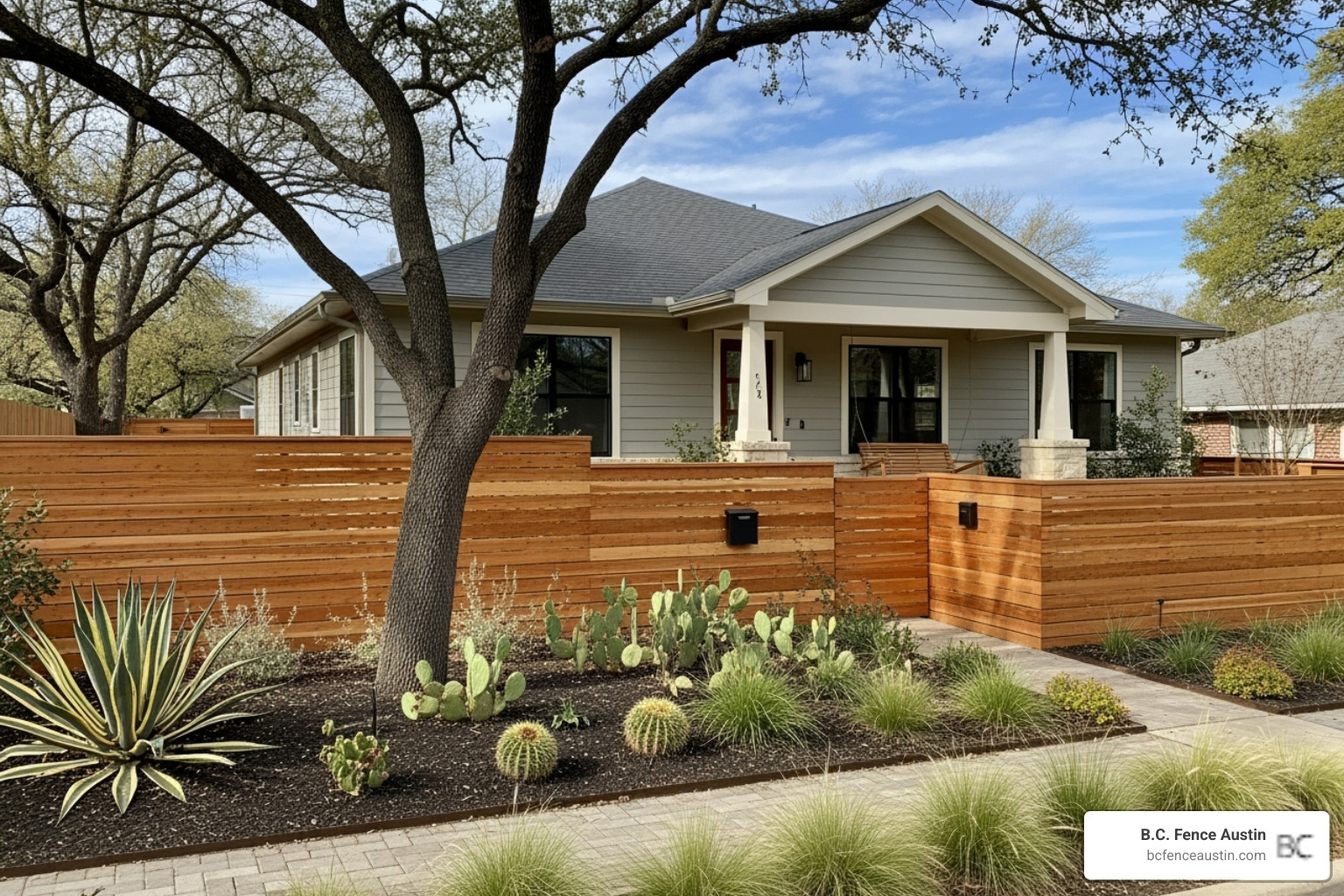
After diving deep into the cedar vs redwood fence debate, you might be wondering: “So which one should I actually choose?” The honest answer is that both are fantastic options that will serve your family well for decades to come. The “right” choice comes down to what matters most to you.
If you love the idea of lower maintenance and don’t mind spending a bit more upfront, redwood’s natural oils make it a dream to care for. You’ll only need to reseal every three to five years, and that gorgeous reddish-brown color deepens beautifully with age. Plus, with 23% more strength than cedar, it’s built to handle whatever Texas weather throws at it.
If you’re drawn to versatility and value, cedar might be calling your name. It’s readily available here in Central Texas, takes stains and paints like a champ, and with proper care, can easily last 30-40 years. That rustic, knotty character gives your fence personality that’s hard to replicate.
Here’s what we’ve learned from installing hundreds of fences in the Austin area: maintenance matters more than the wood type. A well-cared-for cedar fence will outlast a neglected redwood fence every time. Both woods have natural superpowers against rot and insects, but they need your help to reach their full potential.
Your local climate is on your side too. Austin’s conditions suit both woods well, so you really can’t go wrong with either choice. The key is working with installers who understand how these woods behave in our humid summers and occasional freezes.
At B.C. Fence Austin, we’ve seen the joy on homeowners’ faces when their new fence transforms their backyard into a private oasis. Whether you choose the rich elegance of redwood or the versatile charm of cedar, we’re here to make sure your investment pays off for years to come.
Ready to move forward? We’d love to walk your property with you and talk through your specific needs. Sometimes seeing the options in person makes the decision crystal clear. Explore our wood fence services and let’s start planning your perfect fence together.
